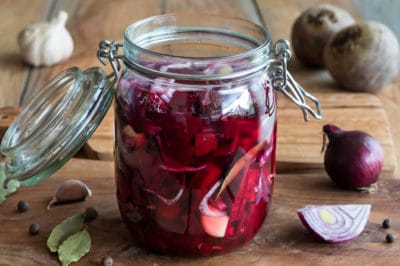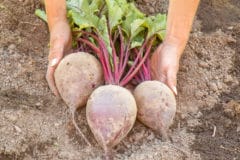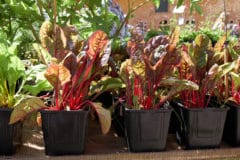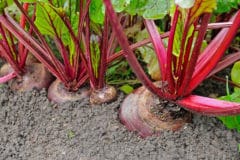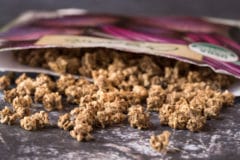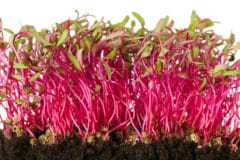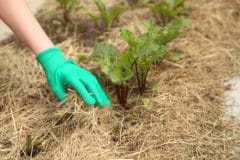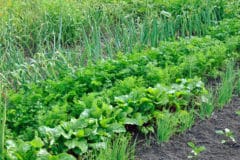Growing for Best Storage
Give your beets the best possible start in the storage game by providing ideal growing conditions. Beets like a fertile soil at least 10 inches deep that’s rich in nutrients, especially phosphorus. Go easy on nitrogen, however. The ideal pH is between 6.0 and 6.8. Keep the soil evenly moist.
Best Varieties for Storage
Although almost any beet can be stored in different ways, certain varieties are better for different kinds of storage. Choose the following for:
- Canning – Detroit Dark Red, Cylindra, Little Ball
- Freezing – Detroit Dark Red, Cylindra
- Pickling or Fermenting – Ruby Queen
- Garden Storage – Crosby’s Egyptian, Flat of Egypt, Lutz Green Leaf
Best Varieties for Greens
Although you can use greens from any beet variety, some have a better flavor or are more tender. For greens, it’s best to harvest young – about six to eight inches long. Older greens are more likely to be tough. These are good choices:
- Detroit Dark Red
- Golden
- Bull’s Blood
- Early Wonder Tall Top
Choosing Beets for Storage
For storing the best way, when harvesting choose beets that are smooth and unblemished, especially if you plan to store or process them whole. Two inches in diameter is a good size for most uses. The beet should have healthy, deep green leaves. Avoid beets with large, hairy tap roots – they may be tough.
Beets in the Refrigerator
For short term storage of a few beets, your refrigerator is a great choice. Trim leaves to within an inch of the root. Don’t clip the root end; the beets may rot. Wash off soil but allow to dry before storage. Place in perforated plastic bags in the crisper drawer.
Root Cellar
Like most root crops, beets store well in a root cellar. The temperature should be 32°F to 40°F (-1°C to 4°C) and humidity around 95 percent. Brush off soil, but don’t wash. Trim off leaves but not roots. You can use sand, sawdust or peat moss for insulation. Pack so beets aren’t touching.
Beet Greens in the Refrigerator
When it comes to beet leaves, storing in the refrigerator is the best way for short-term storage. Cut the leaves from the roots, wash the leaves and place in a perforated plastic bag in the crisper drawer. Don’t cut them up, as they’ll spoil faster.
Freezing Beet Greens
Like spinach and chard, beet greens can be frozen. Choose young, unblemished leaves with small stems. Wash thoroughly. Blanch in boiling water for 2 minutes, cool quickly in ice water and drain. Package while still slightly wet and freeze. Pack tightly and press air out of the package.
Freezing Beets
Beets can be frozen. They must be cooked first until fork tender, then quickly chilled in ice water. Peel and cut after cooking. Small beets can be frozen whole, while larger beets should be sliced or julienned. Freeze individually on trays first, then package for long term storage. Make sure all air is squeezed out of the package.
Canning Beets
As with freezing, small beets can be canned whole, in slices or julienned, as well as diced. Find a tested recipe and follow instructions to the letter. Beets must be pressure canned – a water bath is not safe. Canning is one of the best long-term storage options for beets. Store jars in a cool, dry place.
Pickling Beets
Most pickled beet recipes use vinegar as the preservative. In addition the recipe may include spices or additions like onions or herbs such as dill. As with canning, follow a tested recipe. Pickled beets can be refrigerated for a few weeks but must be canned for long-term storage.
Fermented Beets
Fermenting is a very old method of food preservation that relies on beneficial lactobacillus bacteria. Diced or julienned beets are best for these recipes. Once fermented, store the beets in a root cellar or refrigerate. Fermented beets have a sweeter, less harsh flavor than pickled beets, as most recipes don’t use vinegar.
Dehydrated Beet Roots
Beet “chips” can be made from thinly sliced raw beets. Wash, peel and slice with a mandoline or very sharp knife. Salt lightly if desired. Follow your dehydrator’s instructions. Seal in glass jars or plastic bags when dry and store in a cool, dry place. Eat as you would potato chips.
Dehydrated Beet Greens
Cut leaves away from stems. Wash and gently pat dry or spin in a salad spinner to remove water. Lay the leaves in a single layer on dehydrator trays and dehydrate four four to six hours at 125ºF (52ºC). Crumble into powder and store in glass jars or store whole dried leaves in plastic bags.
Garden Storage in Cool Climates
Beets are a cool season vegetable and can be stored in the ground all winter. Choose overwintering varieties. If you live in areas where the ground freezes solid or there is heavy snow, use about eight inches to a foot of mulch. This helps prevent heaving or cracking and makes them easier to get out of the ground.
Garden Storage in Warm Climates
While you can store beets in the garden, it’s a little trickier in warm climates. Plant in early fall so they won’t get too big. Odds are they won’t last all winter, so plan to harvest and eat as soon as they reach two inches in diameter. Provide moisture and some shade to help cool the soil.
How Long Will Stored Beets Keep?
Storage times vary according to how and where you store.
- Frozen roots – 10 months
- Frozen greens – 10 to 12 months
- Canned/pickled roots – 12 months
- Fermented roots – six months or more
- Roots in gardens – several months depending on temperatures
- Roots in root cellar – two to three months
- Refrigerated roots – two to three weeks
- Refrigerated greens – two to five days
- Dehydrated roots/greens – three to four months
Manage Your Storage
It’s important to pay attention to your stored beets. Check beets in a root cellar at least once a week for signs of rot; remove beets that show rot. Keep an eye on canned beets for signs of leaking seals or cracked jars. Check fermented beets for mold at least once a week. Dehydrated beets may also mold if not kept thoroughly dry.
